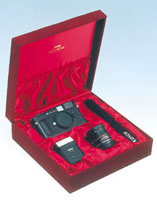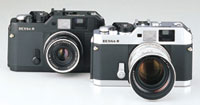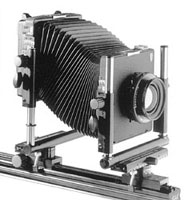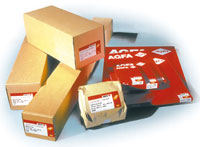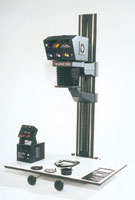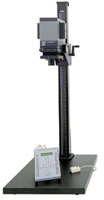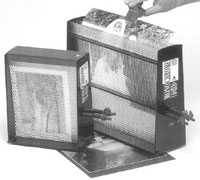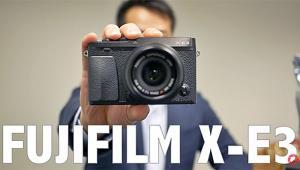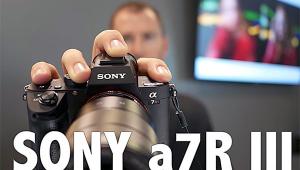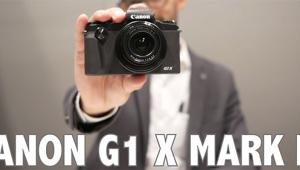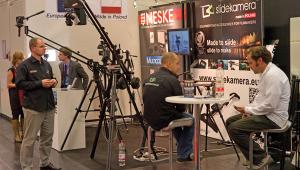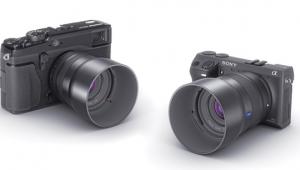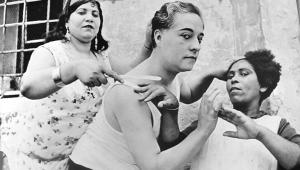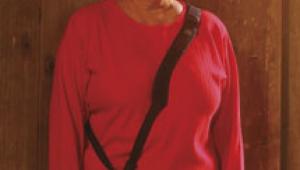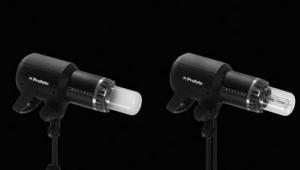Rangefinder, Panoramic, And Large Format Cameras, Plus The Darkroom
Rangefinder Cameras. If the only thing keeping you from becoming a proud owner of a Contax G2 was the lack of a zoom lens, then wait no longer; Contax has announced the Carl Zeiss 35-70mm Vario-Sonnar T* zoom lens. Constructed with environmentally friendly N-glass (no lead or arsenic), the 13-element optic couples to the G2's zoom viewfinder, for continuous focal length selection throughout its range. Maximum aperture is f/3.5, minimum aperture is f/22, and closest focus is 3.3'. Weight is 10.5 oz, and the filter thread is 46mm. It is characterized by a high degree of correction at the wide angle end of its range, making it a no-compromise travel lens. |
|
Konica was showing their new Hexar RF, the long-awaited interchangeable lens version of the original Hexar that developed a loyal following over the years. The new RF features a rugged, die-cast aluminum body with a titanium cover, finished in black. Its vertical travel, focal-plane shutter tops out at 1/4000 sec; metering is TTL, center-weighted, with a choice of aperture-priority or manual modes. The three available lenses include a 50mm f/2, 28mm f/2.8, and 90mm f/2.8. Film advance is motorized, with a maximum rate of 2.5 fps in continuous mode. A dedicated HX-18W electronic flash unit is offered, which covers the field of view of the 28mm lens with no add-on attachments required. |
|
If you liked the Voigtländer Bessa-L (THK Photo Products) introduced last year, but bemoaned the lack of a rangefinder, then rejoice, the gods were listening! Basically the same as the L, the new Bessa-R adds a coupled optical rangefinder, allowing precise focusing with longer lenses. Available in silver or black finish, the compact, die-cast aluminum body features traditional thumb-wind film advance, TTL metering with LED readout in the viewfinder, and a focal-plane shutter with a 1/2000 sec top speed. The lens mount is Leica L (screw mount), and all available Bessa-L/R lenses are usable on screwmount Leicas, as well as on M-series Leicas with adapter. Focal length choices include 15mm, 25mm (these two aren't rangefinder coupled), 35mm (three versions, including an f/1.7 Ultron Aspherical), 50mm Nokton f/1.5 Aspherical, plus 75mm f/2.5 and 90mm offerings. Finder brackets cover 35mm, 50mm, 75mm, and 90mm lenses; the 15mm and 25mm have separate shoe-mount optical finders. Voigtländer has even announced a VC Light Meter, a 1.47 oz shoe-mount unit for classic cameras that were originally meterless, or for 1960s-'70s cameras whose meters have died and are no longer repairable. Available in silver or black, the silicon-celled meter uses two SR-44 (S 76) batteries and accommodates films from ISO 25 to 3200; readout is via three LEDs. Three dual-mounting adapters allow fitting the meter and a separate optical viewfinder simultaneously. Neat! Hey, rangefinder fans, it's been a long time since you've had it this good! Panoramic Cameras. The Russian-made Horizon 202 (Kiev USA) swing-lens 35mm panoramic camera has been upgraded as the Horizon 202s. The two most significant changes are a higher, 1/500 sec top "shutter" (drum) speed, and a much quieter lens/drum travel. |
|
The German-made Noblex (R.T.S. Inc.) line of swing-lens panoramic cameras now incorporate several improvements, including a much more robust camera-to-tripod interface surface and stainless steel gears. An oversize wind knob has been added, along with a new "start" button to avoid film loading mistakes. Most models now accept the Panolux exposure module. These changes are common to all formats of Noblex cameras (35mm, 6x12cm, 6x17cm). |
|
Large Format. Hoffman Camera was showing their new Light Weight 4x5 wood field camera, available in three versions. The front standard has all movements; the model differences are in the degree of rear standard movements. One version provides only rear swing; next up the ladder provides swing and side shift; the third choice adds rise and a patented Glidamatic swing for a high degree of control. International backs are standard, with Graflock-type back optional. Weight ranges from 3 lbs to 4 lbs, and the cameras are finished in black. Linhof (HP Marketing Corp.) isn't the first brand that comes to mind with most photographers when looking for an economical, entry-level 4x5 monorail view camera. The downside of most entry-level view cameras is a limited range of movements, fixed bellows, and light-duty construction. The end result is a camera that's frustrating to use and quickly outgrown. The Linhof Kardan M 4x5, however, is proof that this state of affairs is not unavoidable. At $1170 ($1495 w/150mm lens, $1595 w/210mm lens), it is competitive with any quality monorail view. Of rigid, all-metal construction, the Kardan M features a full range of central swings and tilts, plus yaw-free shifts. Angle scales read to 70° in 1° increments; a millimeter scale on the monorail facilitates depth of field calculations. The bellows is interchangeable, and the camera can be upgraded to Kardan GT 45 specs with tri-axial adjustments. Educational institutions and full-time photography students should inquire about HP Marketing's school purchase program, which offers substantial discounts. |
|
Darkroom. Agfa announced their new Signum Monochrome RA paper. Compatible with standard RA-4 color print chemicals, it produces black and white prints from color and black and white negatives. It avoids the color castes often experienced when printing black and white images on color papers. It is available in standard roll sizes for minilab use, as well as sheet sizes for custom lab and home use. Beseler has joined forces with Trebla Chemical to produce and market Color By Beseler color chemicals, including the ambient temperature RA4 AT. Benefits of the reformulations include scent masked RA-4 developers; odorless bleach/fix; complete bleaching of ISO 1600 T-grain films without premature bleach depletion; advanced optical brightening for brilliant whites; easy mixing in hard water; solutions are formaldehyde-free. Beseler has also improved their VC and Dichro color light sources for the 23CIII enlarger. Enhancements include a smoother white light actuator mechanism and spring; easy-grip white light focus lever; VC head has a smooth, friction driven paper type selector. |
|
De Vere (Odyssey Sales) enlargers are back again. Featured were the 203, which comes with a color head (color to 6x7cm, black and white to 6x9cm), and the Extended Bench 504 model for 4x5 format and under. The 504 can produce 24x30" prints on the baseboard. Both models are rock-solid, industrial grade machines, with control wheels for elevation and focus at the front of the baseboard. This makes focusing large prints a snap, and prevents backaches and a banged head from groping for column cranks in the dark. Dunco (Phomage) enlargers are unfamiliar to most Americans, but the German-made machines have been popular in Europe for years, and now have a North American distributor. Featured was the new Model II-67 Vario Split, which offers precise electronic control of contrast and exposure, via a baseboard console unit and probe. The console's microprocessor directly controls a step motor in the VC head, providing contrast increments as small as 1/10 of a grade. The enlarger itself is very sturdy in the German tradition, covers all formats up to 6x7cm, and has a tilting lens stage for perspective correction. If you're really into variable contrast printing, you should definitely check out the Vario Split. Look for a review of this enlarger in an upcoming issue of Shutterbug. |
|
Forte (Satter/ Omega) is offering a new 4-Roll Film and Paper Student Pack, as a value-priced introduction to their films and papers. It includes four rolls of 35mm, 36 exposure Fortepan 400 black and white negative film, and a 25 sheet package of 8x10 Polygrade V RC variable contrast paper (choice of glossy or semimatte). Fortepan 400 features a unique dual emulsion for maximum detail in highlights and shadows. Polygrade V is one of the more cooperative RC papers for toning. New at the Ilford booth was Multigrade RC Cooltone, a variable contrast paper with, as the name implies, a tonality that's cooler than Ilford's mostly very neutral papers. Don't expect to see a blue caste; Cooltone isn't dramatically "cold," but the difference is fairly obvious when compared to regular Multigrade. It should be welcomed by industrial and architectural photographers, who often favor cold tone papers for their "hard" subjects. With the addition of Cooltone, Ilford Multigrade users now have the widest pallet of black and white tonality available to them, along with regular Multigrade and Multigrade Warmtone. |
|
For darkroom workers who like Jobo's plastic UniTank for its leak-free qualities for inversion processing, but have wished they could use stainless steel reels, Jobo now offers the Stainless Uni-Reel 35 (No. 1565) for 35mm film. It features a large center hole that fits the UniTank's reel shaft, and is of robust construction. Jobo's new ATL-800 automatic film processor takes up only 14x17" of floor space, yet features a built-in rinse-water heater (avoiding the need for a mixing panel) and battery back-up in case of a power failure. It processes color negative film, color transparency, and black and white film; capacity is two rolls of 35mm, two rolls of 120, one roll of 220, or six sheets of 4x5 film. |
|
Kodak has announced improvements in three of its E-6 film processing solutions: Kodak Professional First Developer Starter and Replenisher is cleaner working, more stable, has reduced foam formation, and is more environmentally friendly; Kodak Professional Reversal Bath and Replenisher is cleaner working, lower priced, and has a longer work life; Kodak Professional Final Rinse & Replenisher features a new surfactant to reduce streaking and spotting at the drying stage. Kodak also introduced their Ektacolor Royal VIII and Edge 8 color papers, designed to provide photofinishers with an optimal two paper solution for optical and digital printing requirements. |
|
Nova (Jobo) introduced 8x10" and 12x16" Monochrome models of their popular slot-type paper processors. These models differ from the color capable models largely by the absence of heating controls. The units have compact footprints, requiring much less space than a traditional array of open trays. Very little solution is exposed to the air (the processor can be capped when not in use), resulting in greatly prolonged chemical life. Translucent panels allow viewing the print in progress. There are three slots, and the processors come with a Nova Print Clip that keeps your hands out of the chemicals. Also from Nova was the unique 5 Star Plus safelight. Featuring a variable intensity control, the detached five LED light heads are connected to the power supply via 2 meter or 4 meter cables. The idea is to arrange the light heads around your darkroom work area wherever needed, avoiding the typical one safelight, hot spot/black hole lighting conditions. Additional light heads can be daisy-chained to the power supply. The spectral output of the 5 Star Plus is safe for black and white graded and VC papers, RA-4 paper, and all color reversal papers, including Ilfochrome and Kodak R3000. |
|
Oriental (International Supplies) Hyper Seagull, an RA-4 process paper designed to print black and white images from color and black and white negative films, will soon be available in sheets (previously in rolls only). A cold tone version is available in glossy or matte surfaces, while a sepia tone version comes in matte only. Either matte paper is recommended for handcoloring. |
|
Paterson black and white chemicals (Tiffen) have been absent from the US for a number of years, and were missed by many darkroom workers. Well, weep no more, Paterson is back, and the various formulas have since evolved to keep pace with the more complex requirements of current films and papers. The line-up includes four film developers: Acutol provides medium grain and high acutance for conventional films up to ISO 125; Aculux 2 delivers a tighter grain structure and improved highlight/shadow detail, and is suitable for all black and white films, including the new high tech types; FX-39 complements the characteristics of advanced grain technology films such as Kodak T-Max and Ilford Delta, though it also performs well with conventional films up to ISO s200; Varispeed is tailored to modern films intended for "push" processing, allowing exposure indexes of up to eight times the film's normal ISO rating. |
|
Acuprint is a good general purpose print developer; print capacity of 1 liter of working solution is around 80 8x10 prints. Acugrade is designed specifically for today's fast-printing, short-developing variable contrast papers, ensuring good D-max and separation in the shadows. Acufix is a fast-acting fixer for film and prints, and is quite resistant to developer carry-over for longer working life. It uses an anti-swelling agent, rather than a hardener, thus minimizing wash times and improving toner receptiveness. |
|
Paterson Acutone toners include sepia, red, blue, selenium, and gold. The resultant tints can be varied through dilution and time, and the selenium and gold toners enhance print archivality as well. The Paterson chemicals are available in 300ml, 600ml, and 1200ml sizes, and claim a three-year shelf life when properly stored. Saunders/LPL (Tiffen) has announced the ET-400 Digital Enlarging Timer. Affordably priced, it is microprocessor controlled, with two timing ranges: 0 to 999 in seconds, and 0 to 99.9 in tenths of a second. Not just an enlarger timer, the ET-400 can also time film and print development, or any other timed darkroom operations, and features auto-reset. The three control knobs are illuminated, and a large Start button aids confident implementation in the dark. The safelight outlet turns the safelight off when the Start button is pressed, and an optional foot switch is available. |
- Log in or register to post comments

